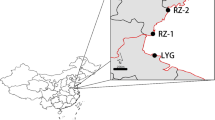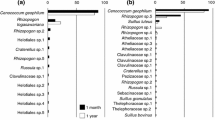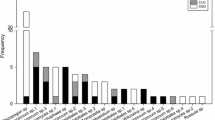Abstract
We investigated the ectomycorrhizal (ECM) fungal colonization status of Pinus thunbergii mature trees and regenerating seedlings varying in age in coastal pine forests on the east coast of Korea. We established one 20 × 20-m plot at each of two study sites at P. thunbergii coastal forests in Samcheok. Fifty soil blocks (5 × 5 × 15 cm) were sampled at regular intervals, and ten P. thunbergii seedlings of age 0, 1–3, 3–5, and 5–10 years were sampled in each study plot. In total of 27 ECM fungal taxa, Cenococcum geophilum was dominant, followed by Russula sp., Sebacina sp., and unidentified Cortinuris sp. in mature trees. In 0-year-old seedlings, some fungal species such as Sebacina sp., C. geophilum, and unidentified Cortinarius sp. were dominant whereas only C. geophilum was dominant after 1 year, and there were no apparent succession patterns in ECM fungal compositions beyond a host age of 1 year. Most ECM fungal taxa that had colonized seedlings of each age class were also observed in roots of mature trees in each site. These taxa accounted for 86.7–100% and 96.4–98.4% of ECM abundance in seedlings and mature trees, respectively. The results indicate that the species composition of ECM fungal taxa colonizing seedlings of different age in forests is similar to that of surrounding mature trees. Our results also showed that C. geophilum is a common and dominant ECM fungus in P. thunbergii coastal forests and might play a significant role in their regeneration.




Similar content being viewed by others
References
Agerer R (1995) Anatomical characteristics of identified ectomycorrhizas: an attempt towards a natural classification. In: Varma AK, Hock B (eds) Mycorrhiza: structure, function, molecular biology and biotechnology. Springer, Berlin, pp 685–734
Baier R, Ingenhaag J, Blaschke H, Göttlein A, Agerer R (2006) Vertical distribution of an ectomycorrhizal community in upper soil horizons of a young Norway spruce (Picea abies [L.] Karst.) stand of the Bavarian Limestone Alps. Mycorrhiza 16:197–206
Baxter JW, Dighton J (2001) Ectomycorrhizal diversity alters growth and nutrient acquisition of grey birch (Betula populifolia) seedlings in host-symbiont culture conditions. New Phytol 152:139–149
Choi MG (1986) Characteristics of salt tolerance in tree species (in Korean with English abstract). J Korean For Soc 29(2):1–8
Chun KW, Lee JH, Kim KN, Seo YKJ, JC Ma HS, Park MS, Ezaki T (2008) The present status and future task of seaside protection forest in Korea (in Japanese with English abstract). J Jpn Soc of Coast For 7(2):21–25
Coleman MD, Bledsoe CS, Lopushinsky W (1989) Pure culture response of ectomycorrhizal fungi to imposed water stress. Can J Bot 67:29–39
Colwell RK (2005) EstimateS: statistical estimation of species richness and shared species from samples. Version 7.5. http://purl.oclc.org/estimates
Dearnaley JDW (2007) Further advances in orchid mycorrhizal research. Mycorrhiza 17:475–486
Dickie IA, Xu B, Koide RT (2002) Vertical niche differentiation of ectomycorrhizal hyphae in soil as shown by T-RFLP analysis. New Phytol 156:527–535
Di Pietro M, Churin JL, Garbaye J (2007) Differential ability of ectomycorrhizas to survive drying. Mycorrhiza 17:547–550
Douglas RB, Parker VT, Cullings KW (2005) Belowground ectomycorrhizal community structure of mature lodgepole pine and mixed conifer stands in Yellowstone National Park. For Ecol Manag 208:303–317
Farmer DJ, Sylvia DM (1998) Variation in the ribosomal DNA internal transcribed spacer of a diverse collection of ectomycorrhizal fungi. Mycol Res 102(7):859–865
Fleming LV (1983) Succession of mycorrhizal fungi on birch: infection of seedlings planted around mature trees. Plant Soil 71:263–267
Gardes M, Bruns TD (1993) ITS primers with enhanced specificity for basidiomycetes: application to the identification of mycorrhizae and rusts. Mol Ecol 2:113–118
Gardes M, Bruns TD (1996) Community structure of ectomycorrhizal fungi in a Pinus muricata forest: above- and below-ground views. Can J Bot 74:1572–1583
Gebhardt S, Neubert K, Wöllecke J, Münzenberger B, Hüttl RF (2007) Ectomycorrhiza communities of red oak (Quercus rubra L.) of different age in the Lusatian lignite mining district, East Germany. Mycorrhiza 17:279–290
Ingleby K, Mason PA, Last FT, Fleming LV (1990) Identification of ectomycorrhizas. ITE Research publication no. 5. HMSO, London
Jany JL, Garbaye J, Martin F (2002) Cenococcum geophilum populations show a high degree of genetic diversity in beech forests. New Phytol 154:651–659
Jonsson L, Dahlberg A, Nilsson MC, Kårén O, Zackrisson O (1999) Continuity of ectomycorrhizal fungi in self-regenerating boreal Pinus sylvestris forests studied by comparing mycobiont diversity on seedlings and mature trees. New Phytol 142:151–162
Kataoka R, Taniguchi T, Ooshima H, Futai K (2008) Comparison of the bacterial communities established on the mycorrhizae formed on Pinus thunbergii root tips by eight species of fungi. Plant Soil 304:267–275
Konta F (1999) The decline of pine forests and the vegetational change in the coastal region of the Tokai area, central Japan. Nat Environ Sci Res 12:103–115
Konta F (2001) The present conditions and functions of the coastal forests in Japan (in Japanese with English abstract). J Jpn Soc Coast For 1(1):1–4
Krpata D, Peintner U, Langer I, Fitz WJ, Schweiger P (2008) Ectomycorrhizal communities associated with Populus tremula growing on a heavy metal contaminated site. Mycol Res 112:1069–1079
Landeweert R, Leeflang P, Smit E, Kuyper T (2005) Diversity of an ectomycorrhizal fungal community studied by a root tip and total soil DNA approach. Mycorrhiza 15:1–6
Lee CY, Jeong YH, Kim JH (2005) Actual condition and management plan for the coastal prevention forest (in Korean). International symposium proceeding of the Japanese Society of Coastal Forest and the Korea Society of Coastal Forest, pp 54–55
Matsuda Y, Hijii N (1998) Spatiotemporal distribution of fruitbodies of ectomycorrhizal fungi in an Abies firma forest. Mycorrhiza 8:131–138
Matsuda Y, Hijii N (2004) Ectomycorrhizal fungal communities in an Abies firma forest, with special reference to ectomycorrhizal associations between seedlings and mature trees. Can J Bot 82:822–829
Matsuda Y, Sugiyama F, Nakanishi K, Ito S (2006) Effects of sodium chloride on growth of ectomycorrhizal fungal isolates in culture. Mycoscience 47:212–217
Matsuda Y, Hayakawa N, Ito S (2009) Local and microscale distributions of Cenococcum geophilum in soils of coastal pine forests. Fungal Ecol 2:31–35
Mühlmann O, Peintner U (2008) Mycobionts of Salix herbacea on a glacier forefront in the Austrian Alps. Mycorrhiza 18:171–180
Palfner G, Casanova-Katny MA, Read DJ (2005) The mycorrhizal community in a forest chronosequence of Sitka spruce [ Picea sitchensis (Bong.) Carr.] in northern England. Mycorrhiza 15:571–579
Park WG, Yi MJ, Chun KW, Ezaki T (2002) A study on stand structure of Pinus thunbergii Parl. forests in eastern part of Kangwon-do, Korea (in Japanese with English abstract). J Jpn Soc Coast For 1(2):13–18
Peter M, Ayer F, Egli S, Honegger R (2001) Above- and below-ground community structure of ectomycorrhizal fungi in three Norway spruce (Picea abies) stands in Switzerland. Can J Bot 79:1134–1151
Pigott CD (1982) Survival of mycorrhiza formed by Cenococcum geophilum Fr. in dry soils. New Phytol 92:513–517
Reddy MS, Natarajan K (1997) Coinoculation efficacy of ectomycorrhizal fungi on Pinus patula seedlings in a nursery. Mycorrhiza 7:133–138
Saleh-Rastin N (1976) Salt tolerance of the mycorrhizal fungus Cenoccocum graniforme (Sow.) Ferd. Eur J For Pathol 6:184–187
Selosse MA, Setaro S, Glatard F, Richard F, Urcelay C, Weiß M (2007) Sebacinales are common mycorrhizal associates of Ericaceae. New Phytol 174:864–878
Taniguchi T, Kanzaki N, Tamai S, Yamanaka N, Futai K (2007) Does ectomycorrhizal fungal community structure vary along a Japanese black pine (Pinus thunbergii) to black locust (Robinia pseudoacacia) gradient? New Phytol 173:322–334
Taylor DL, Bruns TD (1999) Community structure of ectomycorrhizal fungi in a Pinus muricata forest: minimal overlap between the mature forest and resistant propagule communities. Mol Ecol 8:1837–1850
Tedersoo L, Kõljalg U, Hallenberg N, Larsson KH (2003) Fine scale distribution of ectomycorrhizal fungi and roots across substrate layers including coarse woody debris in a mixed forest. New Phytol 159:153–165
Ter Braak CJF, Smilauer P (2002) CANOCO reference manual and CanoDraw for Windows user’s guide: software for canonical community ordination (version 4.5). Microcomputer Power, Ithaca
Teste FP, Simard SW, Durall DM (2009) Role of mycorrhizal networks and tree proximity in ectomycorrhizal colonization of planted seedlings. Fungal Ecol 2:21–30
Twieg BD, Durall DM, Simard SW (2007) Ectomycorrhizal fungal succession in mixed temperate forests. New Phytol 176:437–447
Urban A, Weiß M, Bauer R (2003) Ectomycorrhizas involving sebacinoid mycobionts. Mycol Res 107:3–14
Valentine LL, Fiedler TL, Hart AN, Petersen CA, Berninghausen HK, Southworth D (2004) Diversity of ectomycorrhizas associated with Quercus garryana in southern Oregon. Can J Bot 82:123–135
Visser S (1995) Ectomycorrhizal fungal succession in jack pine stands following wildfire. New Phytol 129:389–401
White TJ, Bruns TD, Lee S, Taylor J (1990) Analysis of phylogenetic relationships by amplification and direct sequencing of ribosomal RNA genes. In: Innis MA, Gelfand DN, Sninsky JJ, White TJ (eds) PCR protocols: a guide to methods and applications. Academic, New York, pp 315–322
Wu B, Nara K, Hogetsu T (1999) Competition between ectomycorrhizal fungi colonizing Pinus densiflora. Mycorrhiza 9:151–159
Acknowledgments
This study was carried out with the support of “Forest Science & Technology Projects (Project No. S210809L010110)” provided by the Korea Forest Service. We acknowledge special support from the members of the Forest Resources Development and Resources Protection Laboratories at Kangwon National University.
Author information
Authors and Affiliations
Corresponding author
Rights and permissions
About this article
Cite this article
Obase, K., Cha, J.Y., Lee, J.K. et al. Ectomycorrhizal fungal communities associated with Pinus thunbergii in the eastern coastal pine forests of Korea. Mycorrhiza 20, 39–49 (2009). https://doi.org/10.1007/s00572-009-0262-1
Received:
Accepted:
Published:
Issue Date:
DOI: https://doi.org/10.1007/s00572-009-0262-1




